托福阅读备考训练技巧和做题策略汇总介绍
托福阅读题技巧

托福阅读题技巧在托福阅读考试中有什么技巧呢,下面我给大家介绍一下托福阅读做题技巧。
托福阅读题技巧篇一1.充分利用上下文语境在考试过程中,我们通常不会也不可能熟悉所有的单词或看懂所有的句子,碰到这种状况,不要惊慌,学会从上下文已知信息中构建完整的文章结构,对句意进行合理推测2.在阅读之前,考生应当快速地阅读一下文章的标题和小标题。
文章的标题往往涵盖了文章的重要内容,小标题则是对文章的局部内容做出了精准的诠释。
3.阅读时随手记笔记,阅读时将每一段文章大意用1-3个词标记出来。
关于长篇幅的文章就可以在略读一遍之后迅速掌握文章整体大意,实际上这也是构建基本大纲的过程。
这个过程关于提升做题速度和正确率都有很大帮助。
托福阅读题技巧篇二1.关注题目制定当中的问题。
在阅读每个段落之前,可以先预览后面的问题设置,画出问题中的关键词,对阅读的目的和必须解决的问题了然于心,做到有的放矢。
2.进入文章正文之前,快速扫描一下文章中穿插的图像,照片,流程图和地图以及图片下方的文字。
托福阅读文章中加入的图片并不是出题人一时心血来潮,而是为了增进应试者的直观理解,更有效地传递文章背景信息。
漠视这些辅助材料等于为难自己。
3.在阅读的过程中,将上一步文章中提出的问题铭记在心,带着问题进行阅读。
由于我们已经检察过全篇内容,已设定好了阅读的目的,此时的阅读是一个筛选材料的过程。
我们有选择性地阅读与文章后提到的问题直接相关的部分,跳过那些无关紧要的细枝末节。
托福阅读注意事项1.托福阅读考试的题目解答,必须要按照考生的习惯进行。
哪类题目掌握的熟练就先解哪一类题目。
2.关于托福考试而言,错题也是不扣分的,考试的时候留白也是很不明智的。
3.不要重点关注难题,要关注容易拿到分的题目。
大家平常的复习时间不要花在偏题怪题上面,主心骨还是放在中等规范的题目中。
以上就是托福托福阅读做题技巧的内容,希望对大家有所帮助哦。
托福阅读答题方法技巧主要有哪些
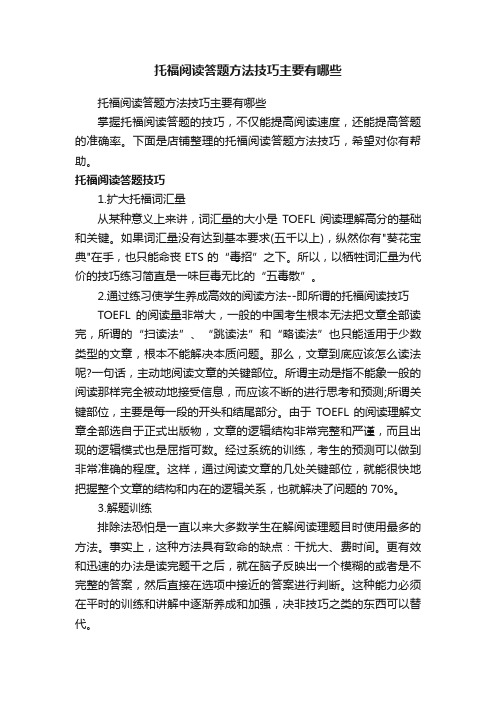
托福阅读答题方法技巧主要有哪些托福阅读答题方法技巧主要有哪些掌握托福阅读答题的技巧,不仅能提高阅读速度,还能提高答题的准确率。
下面是店铺整理的托福阅读答题方法技巧,希望对你有帮助。
托福阅读答题技巧1.扩大托福词汇量从某种意义上来讲,词汇量的大小是TOEFL阅读理解高分的基础和关键。
如果词汇量没有达到基本要求(五千以上),纵然你有"葵花宝典"在手,也只能命丧ETS的“毒招”之下。
所以,以牺牲词汇量为代价的技巧练习简直是一味巨毒无比的“五毒散”。
2.通过练习使学生养成高效的阅读方法--即所谓的托福阅读技巧TOEFL的阅读量非常大,一般的中国考生根本无法把文章全部读完,所谓的“扫读法”、“跳读法”和“略读法”也只能适用于少数类型的文章,根本不能解决本质问题。
那么,文章到底应该怎么读法呢?一句话,主动地阅读文章的关键部位。
所谓主动是指不能象一般的阅读那样完全被动地接受信息,而应该不断的进行思考和预测;所谓关键部位,主要是每一段的开头和结尾部分。
由于TOEFL的阅读理解文章全部选自于正式出版物,文章的逻辑结构非常完整和严谨,而且出现的逻辑模式也是屈指可数。
经过系统的训练,考生的预测可以做到非常准确的程度。
这样,通过阅读文章的几处关键部位,就能很快地把握整个文章的结构和内在的逻辑关系,也就解决了问题的70%。
3.解题训练排除法恐怕是一直以来大多数学生在解阅读理题目时使用最多的方法。
事实上,这种方法具有致命的缺点:干扰大、费时间。
更有效和迅速的办法是读完题干之后,就在脑子反映出一个模糊的或者是不完整的答案,然后直接在选项中接近的答案进行判断。
这种能力必须在平时的训练和讲解中逐渐养成和加强,决非技巧之类的东西可以替代。
托福阅读备考时的提分技巧技巧一丶略读略读就是要抓住文章主旨和重要信息,像文章的主题·时间·任务等重要的信息,能够借此迅速的掌握文章的大意以及段落大意。
然后阅读问题,根据问题迅速的定位答案,对答案大概所在段落进行精读。
托福阅读备考技巧

托福阅读备考技巧〔托福〕阅读的难度很大,除了平常的积存之外,也要懂得一定的技巧。
下面是重庆森博〔英语〕我为大家整理的关于托福阅读备考技巧的相关资料,希望帮到大家。
托福阅读备考技巧一:1.了解了托福口语考试到底怎么出题之后,接下来,我们就应该选择一些材料学习!但是自从托福考试进入中国以来,市场中的各种托福口语备考资料可谓是琳琅满目,并不是每一份资料都是可以有效帮助大家备考,提升托福口语成绩的。
建议考生选择血统纯正的由官方出版的一些资料,用以帮助自己了解托福口语出题规律,掌握托福口语答题技巧。
2.略读和精读是相反的概念,考生的略读学习是为了在限按时间内抓住文章重点,所以考生阅读时,重点把握托福阅读段落关键句和段落间关系,略过例子、解释等细节。
当然,考生也要学会精读和略读的方法结合,针对不同内容采纳不同阅读方法。
3.在做托福词汇题时,许多考生认为做不对题与自己的词汇量有关,熟悉单词能做对,不熟悉单词就会做错。
事实上,那些熟悉的单词常常做错,不熟悉的单词反而能做对。
原因是,做不熟悉单词时,考生会仔细研读词汇题的上下文,力求在上下文中突破。
而做熟悉单词时,忽略上下文的重要性,往往是装模作样的看一下上下文,便匆匆做出抉择。
所以,做好词汇题关键在于透彻分析上下文--词汇题的句子以及上下一句话,有时候,各别词汇题或许必须要在文章其他段落寻找线索。
托福阅读备考技巧二:1.托福阅读词汇的学习必须要合计托福阅读核心词汇和学术词。
托福阅读核心词汇多是影响考生理解文章的常用形容词和动词、副词类,通常还会在托福预读词汇题中视察,考生对这类词汇的学习主要参照历年托福阅读词汇总结类资料,可以依据词汇数量规定天天的学习任务并注意巩固,对学术词则主要通过托福阅读TPO文章阅读积存,只必须要熟悉即可。
2.考生应该在阅读前应该通过构词法大量记忆词汇,在词汇达到一定水平常,对托福阅读中的学术词分类熟悉,对核心词进行整理巩固;在句子理解时,考生必须要对语法知识进行补充,了解托福阅读长难句常见类型,学会分析长难句的方法;关于段落,考生要注意把握段落中的重点和次重点,把握段落结构;文章的整体把握建立在对词汇、句子和段落的把握之上,但是考生也要对文章的一般类型、特点进行熟悉。
托福阅读好提分的攻略大全
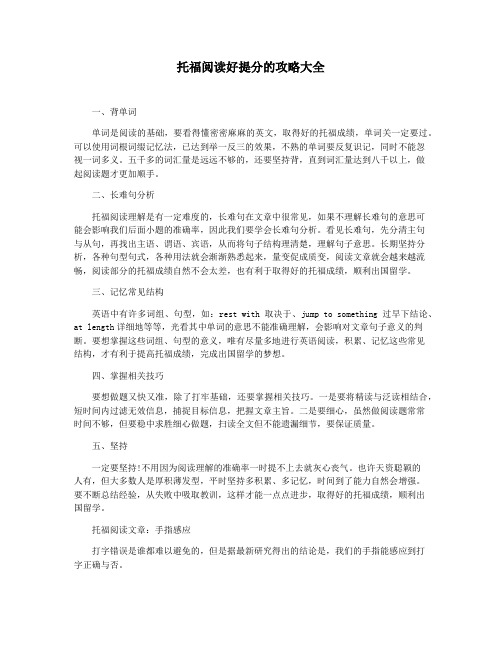
托福阅读好提分的攻略大全一、背单词单词是阅读的基础,要看得懂密密麻麻的英文,取得好的托福成绩,单词关一定要过。
可以使用词根词缀记忆法,已达到举一反三的效果,不熟的单词要反复识记,同时不能忽视一词多义。
五千多的词汇量是远远不够的,还要坚持背,直到词汇量达到八千以上,做起阅读题才更加顺手。
二、长难句分析托福阅读理解是有一定难度的,长难句在文章中很常见,如果不理解长难句的意思可能会影响我们后面小题的准确率,因此我们要学会长难句分析。
看见长难句,先分清主句与从句,再找出主语、谓语、宾语,从而将句子结构理清楚,理解句子意思。
长期坚持分析,各种句型句式,各种用法就会渐渐熟悉起来,量变促成质变,阅读文章就会越来越流畅,阅读部分的托福成绩自然不会太差,也有利于取得好的托福成绩,顺利出国留学。
三、记忆常见结构英语中有许多词组、句型,如:rest with取决于、jump to something过早下结论、at length详细地等等,光看其中单词的意思不能准确理解,会影响对文章句子意义的判断。
要想掌握这些词组、句型的意义,唯有尽量多地进行英语阅读,积累、记忆这些常见结构,才有利于提高托福成绩,完成出国留学的梦想。
四、掌握相关技巧要想做题又快又准,除了打牢基础,还要掌握相关技巧。
一是要将精读与泛读相结合,短时间内过滤无效信息,捕捉目标信息,把握文章主旨。
二是要细心,虽然做阅读题常常时间不够,但要稳中求胜细心做题,扫读全文但不能遗漏细节,要保证质量。
五、坚持一定要坚持!不用因为阅读理解的准确率一时提不上去就灰心丧气。
也许天资聪颖的人有,但大多数人是厚积薄发型,平时坚持多积累、多记忆,时间到了能力自然会增强。
要不断总结经验,从失败中吸取教训,这样才能一点点进步,取得好的托福成绩,顺利出国留学。
托福阅读文章:手指感应打字错误是谁都难以避免的,但是据最新研究得出的结论是,我们的手指能感应到打字正确与否。
Whether you're a hunt-and-peck typist or a Rachmaninoff of the keyboard, you will make mistakes. But it's not just your eyes catching typos when yousee them on the screen. Your hands know whenyou mess up too. That’s according to a study in the journal Science. [Gordon Logan and Matthew Crump, "Cognitive Illusions of Authorship Reveal Hierarchical Error Detection in Skilled Typists"]Researchers recruited expert typists—college students, of course—and showed them 600 five-letter words, one at a time. And they asked the studentsto type those words as quickly and accuratelyas possible. But sometimes, the researchers inserted typos in the wordas it appeared on screen, when the students hadn’t made one. Other times they automatically corrected typos the studentsdid make.And the students tended to believe the screen. So if a typo had been added, they figured they must have messed up. If a typo had been corrected they thought they typed it right. But the handsdidn't fall for it. When the fingers slipped up, they paused a split second longer than usual before typing the next letter. But they didn't pause when fake typos appeared on-screen only. So weapparently have two discrete mechanisms guarding against typing errors, one visual, the other tactile. To fox quick brown fixes. To fix quick brown foxes.托福阅读文章:文化背景决定工作理念在许多企业文化中,“团队合作”被视为非常重要的组成部分,优秀的“团队合作”精神也被视为一个好员工必须具备的。
语言资格备考托福阅读的方法与技巧

语言资格备考托福阅读的方法与技巧在备考托福阅读考试时,采取正确的方法和技巧对于取得好成绩至关重要。
本文将为大家介绍一些备考托福阅读的方法与技巧,希望能帮助大家有效提升阅读能力。
一、理解题目类型在备考托福阅读时,首先要了解不同题目类型的要求。
托福阅读常见的题目类型包括主旨题、细节题、推断题、词汇题等。
对于每种题型,要仔细阅读问题,并在阅读文章时有针对性地寻找答案。
二、拓宽阅读广度托福阅读中的文章覆盖了各个领域的知识,因此要拓宽阅读广度。
在备考期间,多读一些英文书籍、英文报纸、杂志等,尤其是涉及科技、社会、历史等领域的文章。
通过多读不同类型的文章,可以增加对各种话题的了解,扩大词汇量和理解能力。
三、培养阅读速度阅读速度是备考托福阅读考试时的一个关键因素。
要培养自己的阅读速度,可以通过练习提高。
最开始可以选择一些相对简单的文章进行读物,逐渐提高阅读速度。
在阅读时要注意提高理解能力,不要单纯为了追求速度而忽略了文章的内涵。
四、划分重点与次要信息在备考托福阅读时,很多文章都存在大量的细节信息。
为了提高阅读效率,划分重点与次要信息是非常重要的。
重点信息通常是作者的观点、主题句、主要论据等,而次要信息则是支撑论据的细节或者例子。
通过快速准确地划分信息的重要性,可以更好地掌握文章的核心内容。
五、运用词根词缀分析生词托福阅读中常常会出现一些生词,这给阅读带来一定的困难。
为了更好地应对这一问题,可以通过运用词根词缀分析生词的词义。
英语中的很多词汇都有共同的词根或者词缀,通过总结记忆这些规律,可以轻松理解并且记忆生词的词义。
六、练习做题技巧在备考托福阅读时,提前了解并练习做题技巧是很有必要的。
有些题目可能涉及到排除干扰项、找出最佳选项等答题技巧。
通过多做一些模拟题,熟悉不同题型的解题思路和技巧,可以在考试中更加灵活和准确地回答问题。
七、查阅备考资料备考托福阅读过程中,可以查阅一些专门的备考资料,了解一些备考的最新动态和技巧分享。
如何高效备考托福阅读,实用攻略助你拿满分

如何高效备考托福阅读,实用攻略助你拿满分下面我们就从目前所处不同分数的阶段来告诉大家如何拿到〔托福〕阅读高分。
如果目标是0-22分的,就要多背单词,所进行长难句理解,多刷TPO、刷文章;如果目标是22-26分的,可以报班学习,进行一个冲刺;如果目标是26-30分的,必须要多读文章。
具体方法如下。
1、0-22分1) 背单词。
单词是基础,单词分为高频单词,逻辑词,态度词,以及学科词汇,那3个月如何拿到一个相对理想的分数呢,前提是,单词一定不能拖后腿,正常说要考托福的话,8000词汇量是一个基础,所以,我们首先要攻克的是高频单词,逻辑词和态度词。
高频单词就是我们说的托福常考词汇,大家可以下载雷哥单词app 进行记忆和学习。
当然,也可以依据阅读文章,在阅读理解中积存词汇,自己整理出一个词汇书。
逻辑词呢,就是我们说的表达逻辑语义的词汇,比如,however,but,and,or,so,because这类词汇。
态度词就是我们说的表示正态度还是负态度的词汇,如support,for表指出,against,object表反对等。
那学科词汇呢,我们并不做强制要求,如果大家有时间的话,可以积存,去熟识学科类词汇。
2) 长难句理解。
因为托福阅读基本都是长句,我们必须要去分析句子,抓住句子的主干,找到核心意思,如果句子有逻辑关系在里面,则标注。
分析句子主要是在长篇文章中可以找出核心意思,节省时间。
3) 刷TPO、刷文章,一是为了了解托福阅读的题型,掌握整体做题的pace,同时,后期可以进行模考学习。
整个过程中,可以将错题进行归类,后期针对性做题。
2、22-26分22分考生目标是冲26-27,拿22分考生语法和句子理解基本没问题,那主要是针对文章主旨及细节的一个理解,碰到22分瓶颈必须要突破的话,就可以报班学习,进行一个冲刺。
方法掌握了,提分也更容易,少走弯路。
后期可以进行TPO模考,自己限时进行,找出自己问题,针对薄弱题进行针对训练。
托福阅读解题七大技巧

千里之行,始于足下。
托福阅读解题七大技巧托福阅读解题是托福考试中的一个重要环节,对于提高阅读成绩至关重要。
下面是七个托福阅读解题的技巧,希望能对你的备考有所帮助。
1. 理解文章结构:在解题之前,先通读文章,了解文章的整体结构和逻辑关系。
这包括文章的主旨、段落之间的转折和推理关系等。
有一个清晰的结构框架,能够帮助你更好地理解文章细节并快速定位答案。
2. 熟悉题型要求:不同的题型需要采用不同的解题策略。
常见的题型包括细节题、推理题、态度题等。
在考前进行充分的题型分析和练习,熟悉题目要求和解题技巧,有针对性地进行复习和提高。
3. 利用关键词:在解答问题时,关键词是非常重要的线索。
通过识别关键词,可以快速定位到与问题相关的信息。
关键词可以是名词、动词、副词等,通过跟问题中的关键词进行匹配,可以更快地找到正确答案。
4. 注意词义推测:有时候,在文章中不能直接找到答案,需要根据上下文推测词义。
通过对上下文的分析和理解,可以推测未知词汇的意思。
可以根据词的前后关系、句子的语境等进行推测。
5. 注意修饰语:在阅读文章时,注意修饰语对文章的影响很大。
修饰语可以是形容词、副词、介词短语等,它们可以限定名词的范围、改变动词的意义等。
在解答问题时,注意识别和理解修饰语的作用。
6. 解题思路灵活:有时候,题目会设计一些玄妙的干扰答案。
在解答问题时,要保持灵活的思维,不要固定一个答案或一个解题思路。
多角度思考,尝试不同的解题思路,可以帮助你更好地筛选和定位答案。
第1页/共2页锲而不舍,金石可镂。
7. 多做阅读练习:最后一个技巧是进行大量的阅读练习。
托福阅读的解题技巧需要熟练掌握,只有经过频繁的练习和实践,才能提高解题的准确性和速度。
可以通过做真题、模拟题、刷题软件等途径进行练习。
以上是托福阅读解题的七大技巧,希望对你有所帮助。
要记住,在备考过程中,需要不断地实践和总结,找到适合自己的解题方法和策略,提高阅读解题的能力。
祝你取得好成绩!。
托福阅读考试答题的技巧
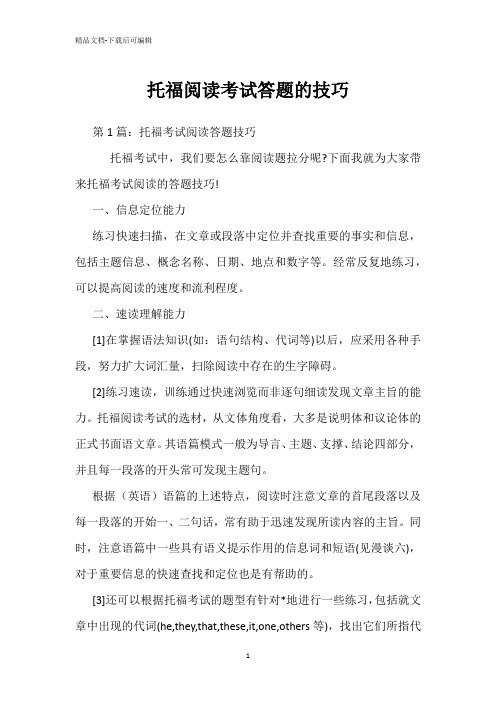
托福阅读考试答题的技巧第1篇:托福考试阅读答题技巧托福考试中,我们要怎么靠阅读题拉分呢?下面我就为大家带来托福考试阅读的答题技巧!一、信息定位能力练习快速扫描,在文章或段落中定位并查找重要的事实和信息,包括主题信息、概念名称、日期、地点和数字等。
经常反复地练习,可以提高阅读的速度和流利程度。
二、速读理解能力[1]在掌握语法知识(如:语句结构、代词等)以后,应采用各种手段,努力扩大词汇量,扫除阅读中存在的生字障碍。
[2]练习速读,训练通过快速浏览而非逐句细读发现文章主旨的能力。
托福阅读考试的选材,从文体角度看,大多是说明体和议论体的正式书面语文章。
其语篇模式一般为导言、主题、支撑、结论四部分,并且每一段落的开头常可发现主题句。
根据(英语)语篇的上述特点,阅读时注意文章的首尾段落以及每一段落的开始一、二句话,常有助于迅速发现所读内容的主旨。
同时,注意语篇中一些具有语义提示作用的信息词和短语(见漫谈六),对于重要信息的快速查找和定位也是有帮助的。
[3]还可以根据托福考试的题型有针对*地进行一些练习,包括就文章中出现的代词(he,they,that,these,it,one,others等),找出它们所指代的名词;根据文章提供的信息,练习推理、预测和归纳结论的能力;选择阅读中遇到的生字,根据前后语句所提供的上下文线索猜测字义。
三、研读整理能力1.训练阅读除需要培养理解文章含义和增强查找信息的能力外,还应适当注意所读材料的组织结构及写作手法,例如:该文章的组织方式可能是比较对照、分类、因果等,某个例子在阐述过程中有何作用。
这有助于理解把握文章内涵和归纳概括内容提要。
2.练习概括提要,区分主要与次要内容。
对于描述过程的文章,可练习按顺序总结步骤,写出提要。
若文章涉及信息分类,可尝试制作图表并将相关内容分类排列。
虽然新托福考试并不要求自己设计分类图表,但这项练习有助于加强信息整理的意识,可以帮*生更快适应此类题型。
如何练托福阅读

如何练托福阅读1、从细处着手(1)扩展词汇量词汇量的大小是阅读理解高分的基础和关键,一般而言,托福阅读的词汇量是8000左右。
由于词汇量要求较高,很多同学采纳快速背诵法来记忆单词,但在托福考试中,对单词的考查不仅是背过单词含义就行,更重要的是学会应用,学会在文章中理解并使用单词。
(2)掌握语法句式有了足够的词汇量,但还是有读不懂的句子,这是因为托福阅读中的英文句子大多不是主、谓、宾的简单组合,其中会穿插多种复杂的修饰成分,如定语后置、介宾结构、倒装、不定式等等,使句意变得扑朔迷离,加大理解的难度。
因此在掌握大量的词汇后,还必须要系统掌握语法和句式知识。
考生掌握不同类型的修饰成分,就能准确抓出主语,清楚各成分间的逻辑关系,有助于快速理解句意。
(3)了解文章的段落结构为了加快做题速度,部分考生只阅读和题目相关的假设干句子,而忽略段落和文章的中心思想和理解。
但有些题目会对原文进行改写或者总结多个段落才有答案,这就要求考生通读段落或文章,而不是简单地定位做题。
当然,阅读文章还是有技巧的,因为选材大多是学术性比较强的文章,而这类文章的特点之一就是大都具有明确的文章结构,往往在段首就直接给出中心内容,因此考生必须特别注意寻找主旨句。
2、从大处着眼(1)精读,提升理解归纳能力精读指的是反复阅读和分析范文句式结构。
初次备考托福阅读的朋友,可能会整理不出段落大意,无法理解句子间的关系,这其实是理解归纳上出现了问题,这个时候必须要考生对文章进行仔细的精读。
精读,就是要吃透文章。
每篇文章看完做完题,考生必须要查阅所有不熟悉的单词并且进行总结,对每个句子做总结,然后扩展到整个段落的总结。
这种方式有助于考生理解句子、段落、文章的关系,把握文章整体逻辑脉络,不仅能提升自身的理解归纳能力,对后面的写作也起到锻炼逻辑思维的效果。
(2)泛读,提升阅读速度泛读是快速广泛的阅读,通常不会逐字逐句的分析记忆。
当考生拥有丰富的词汇量时,可以进行大量的泛读来提升阅读速度。
怎么练托福阅读

怎么练托福阅读一. 托福阅读训练方法1.多刷题,多学习,提升阅读速度在刷题学习之前要强调的一点是,词汇量必必须过关。
从某种意义上来讲,词汇量的大小是托福阅读理解高分的基础和关键。
以牺牲词汇量为代价的技巧学习是完全不可取的,因为基础打不好,根本谈不上任何技巧。
打好基础以后就要多学习了,学习时提升阅读速度是关键。
对托福有了解的同学都知道,托福的阅读量非常大,一般状况下,很多中国考生没办法把文章全部读完,有人提倡"扫读法'、"跳读法'和"略读法',这些方法可能对各别文章有些用处,但并不适用所有题型。
所以,从根本上讲还是要多学习,提升自己的阅读速度。
2.做精读,吃透文章学习托福阅读的时候,一定要做精读。
在阅读当中,精读和泛读都很重要的。
很多同学做了很多TPO,却不返回去分析做错的地方,也不对文章做精读。
如果只刷题,而不看不分析自己存在哪些问题,那读十篇,还不如读一篇。
因为这样的泛读对你是没有一点提升的。
那么如何做精读呢?首先,要整理文章中的单词,然后要分析长难句和文章结构,最后分析错题出错的原因。
二. 托福阅读资料选择1. TPO单项阅读突破TPO是非常经典的学习材料,也是备考托福阅读时必定会用到的,建议考生用TPO阅读题做阅读单项突破学习,把握出题类型和自己易出错的地方,及时分析反思2. 拓宽阅读范围,多读国外学术性杂志和期刊托福阅读备考时不能仅限于刷题,其实托福阅读的文章范围涉猎广泛,所以大家在学习的时候多做extensive reading,提升自己对英文文章的理解能力。
阅读能力的提升是个比较缓慢的过程,必须要长期的积存。
而最好的积存素材就是国外的一些学术性的期刊和杂志。
在做拓展阅读时也要及时积存碰到的生词。
2托福阅读文章时必须要留意的地方先不说托福阅读,即使在平常的对话中如果碰到"但是'"不过'等词的时候大家也知道重点来了,托福阅读文章也是如此。
详解托福阅读的解题技巧和训练方法
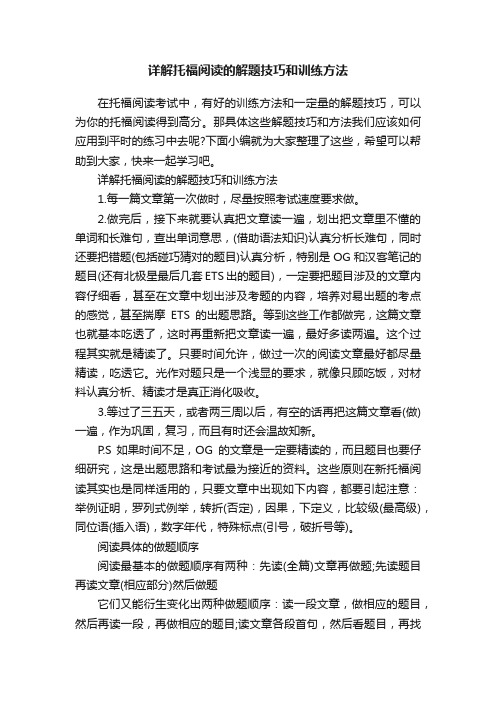
详解托福阅读的解题技巧和训练方法在托福阅读考试中,有好的训练方法和一定量的解题技巧,可以为你的托福阅读得到高分。
那具体这些解题技巧和方法我们应该如何应用到平时的练习中去呢?下面小编就为大家整理了这些,希望可以帮助到大家,快来一起学习吧。
详解托福阅读的解题技巧和训练方法1.每一篇文章第一次做时,尽量按照考试速度要求做。
2.做完后,接下来就要认真把文章读一遍,划出把文章里不懂的单词和长难句,查出单词意思,(借助语法知识)认真分析长难句,同时还要把错题(包括碰巧猜对的题目)认真分析,特别是OG和汉客笔记的题目(还有北极星最后几套ETS出的题目),一定要把题目涉及的文章内容仔细看,甚至在文章中划出涉及考题的内容,培养对易出题的考点的感觉,甚至揣摩ETS的出题思路。
等到这些工作都做完,这篇文章也就基本吃透了,这时再重新把文章读一遍,最好多读两遍。
这个过程其实就是精读了。
只要时间允许,做过一次的阅读文章最好都尽量精读,吃透它。
光作对题只是一个浅显的要求,就像只顾吃饭,对材料认真分析、精读才是真正消化吸收。
3.等过了三五天,或者两三周以后,有空的话再把这篇文章看(做)一遍,作为巩固,复习,而且有时还会温故知新。
P.S 如果时间不足,OG的文章是一定要精读的,而且题目也要仔细研究,这是出题思路和考试最为接近的资料。
这些原则在新托福阅读其实也是同样适用的,只要文章中出现如下内容,都要引起注意:举例证明,罗列式例举,转折(否定),因果,下定义,比较级(最高级),同位语(插入语),数字年代,特殊标点(引号,破折号等)。
阅读具体的做题顺序阅读最基本的做题顺序有两种:先读(全篇)文章再做题;先读题目再读文章(相应部分)然后做题它们又能衍生变化出两种做题顺序:读一段文章,做相应的题目,然后再读一段,再做相应的题目;读文章各段首句,然后看题目,再找文章内相应部分做题对于广大非牛来说,可能“读文章各段首句,然后看题目,再找文章内相应部分做题”会比较合适,读各段首句可以粗略掌握文章大意和结构,做题再看内容再做能大大降低“工作量”,但是这种做法不利于对全文的消化吸收,从而不利于做总结题,也可能会遗漏文章内的一些细节而导致做错细节题。
托福阅读技巧完整版
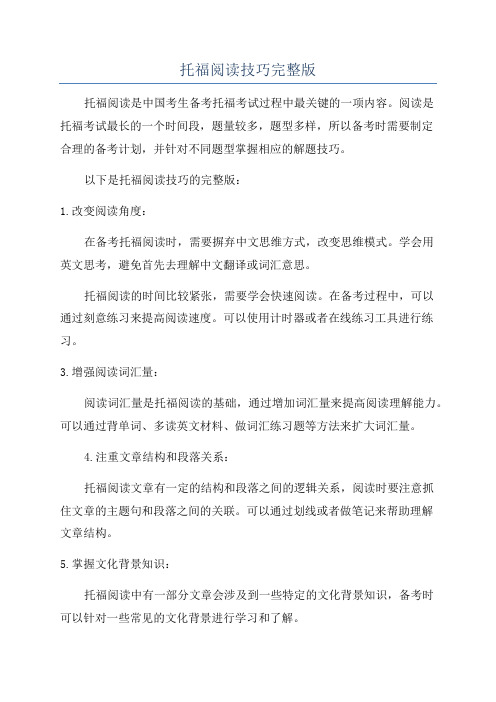
托福阅读技巧完整版托福阅读是中国考生备考托福考试过程中最关键的一项内容。
阅读是托福考试最长的一个时间段,题量较多,题型多样,所以备考时需要制定合理的备考计划,并针对不同题型掌握相应的解题技巧。
以下是托福阅读技巧的完整版:1.改变阅读角度:在备考托福阅读时,需要摒弃中文思维方式,改变思维模式。
学会用英文思考,避免首先去理解中文翻译或词汇意思。
托福阅读的时间比较紧张,需要学会快速阅读。
在备考过程中,可以通过刻意练习来提高阅读速度。
可以使用计时器或者在线练习工具进行练习。
3.增强阅读词汇量:阅读词汇量是托福阅读的基础,通过增加词汇量来提高阅读理解能力。
可以通过背单词、多读英文材料、做词汇练习题等方法来扩大词汇量。
4.注重文章结构和段落关系:托福阅读文章有一定的结构和段落之间的逻辑关系,阅读时要注意抓住文章的主题句和段落之间的关联。
可以通过划线或者做笔记来帮助理解文章结构。
5.掌握文化背景知识:托福阅读中有一部分文章会涉及到一些特定的文化背景知识,备考时可以针对一些常见的文化背景进行学习和了解。
7.多做阅读练习题:托福阅读题型多样,备考时需要多做不同类型的阅读练习题。
可以从官方教材、模拟试题集等练习材料中选择合适的题目进行练习。
8.制定备考计划:备考托福阅读需要制定合理的备考计划。
可以根据自己的时间和能力情况,合理安排每天的备考时间,并制定具体的备考目标。
9.多做模拟考试:模拟考试是检验备考成果的有效方法,可以通过模拟考试来检验自己的备考情况,并找出备考中的问题和不足之处。
可以选择一些官方的模拟试题或者在线模考平台进行练习。
10.注重综合能力培养:托福阅读考察的不仅仅是阅读理解能力,还需要发展综合能力,比如写作能力、逻辑思维能力等。
备考时可以多读英文原著、参加英语角等活动来提高综合能力。
以上就是托福阅读技巧的完整版。
希望以上内容对您备考托福阅读有所帮助!。
托福阅读满分经验和技巧分享
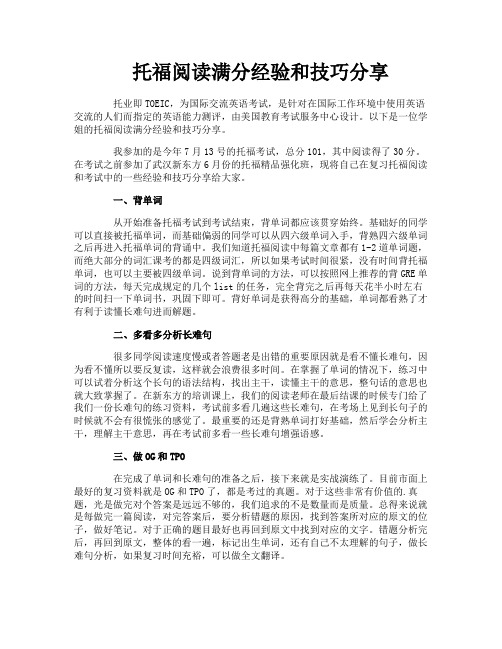
托福阅读满分经验和技巧分享托业即TOEIC,为国际交流英语考试,是针对在国际工作环境中使用英语交流的人们而指定的英语能力测评,由美国教育考试服务中心设计。
以下是一位学姐的托福阅读满分经验和技巧分享。
我参加的是今年7月13号的托福考试,总分101,其中阅读得了30分。
在考试之前参加了武汉新东方6月份的托福精品强化班,现将自己在复习托福阅读和考试中的一些经验和技巧分享给大家。
一、背单词从开始准备托福考试到考试结束,背单词都应该贯穿始终。
基础好的同学可以直接被托福单词,而基础偏弱的同学可以从四六级单词入手,背熟四六级单词之后再进入托福单词的背诵中。
我们知道托福阅读中每篇文章都有1-2道单词题,而绝大部分的词汇课考的都是四级词汇,所以如果考试时间很紧,没有时间背托福单词,也可以主要被四级单词。
说到背单词的方法,可以按照网上推荐的背GRE单词的方法,每天完成规定的几个list的任务,完全背完之后再每天花半小时左右的时间扫一下单词书,巩固下即可。
背好单词是获得高分的基础,单词都看熟了才有利于读懂长难句进而解题。
二、多看多分析长难句很多同学阅读速度慢或者答题老是出错的重要原因就是看不懂长难句,因为看不懂所以要反复读,这样就会浪费很多时间。
在掌握了单词的情况下,练习中可以试着分析这个长句的语法结构,找出主干,读懂主干的意思,整句话的意思也就大致掌握了。
在新东方的培训课上,我们的阅读老师在最后结课的时候专门给了我们一份长难句的练习资料,考试前多看几遍这些长难句,在考场上见到长句子的时候就不会有很慌张的感觉了。
最重要的还是背熟单词打好基础,然后学会分析主干,理解主干意思,再在考试前多看一些长难句增强语感。
三、做OG和TPO在完成了单词和长难句的准备之后,接下来就是实战演练了。
目前市面上最好的复习资料就是OG和TPO了,都是考过的真题。
对于这些非常有价值的.真题,光是做完对个答案是远远不够的,我们追求的不是数量而是质量。
托福的阅读应试技巧

托福的阅读应试技巧大家在做托福阅读的时候如果掌握到关键技巧,就会达到事半功倍的效果,下面我给大家分享一些托福阅读应试技巧好了。
托福阅读考试练习题目做题方法介绍托福阅读考试练习题目做题方法一:顺序做题在这样的方法中,通常大家都会用5分钟左右的时间阅读完整篇文章,而将大概的重点都放在文章的结构和关键内容的理解中。
而剩余的15分钟时间,就会从题目的第一题顺序做到最后一题。
也就是说,文章应对题目,看了一段题目后,找到相应要解决掉的题目。
这样的方法相信是大部分备考学生都会采用到的。
其优点在于,可以让大家对于整题的文章有了一定的把握,同时,容易理解文章的细节信息,建立阅读的自信。
当然,其中的确定就是,很难控制好答题的时间,另外在做最后一题时候,往往会需要我们在重新阅读一下整篇文章。
托福阅读考试练习题目做题方法二:最后一题优先而针对以上这样的问题,很多同学也曾经考虑过改变顺序从而应对答题时间的问题。
也就是是说,在阅读完整篇文章之后,先做最后一到小结题,然后再从第一题做到倒数第二题。
当然,这样方法有着一定的好处,因为在刚刚阅读结束后对于整篇文章有着比较深的印象,在完成最后一题是能有比较高的准确率。
但如果在这道题中稍稍耽搁了一会儿,也将会之后解题带来很大的时间压力。
托福阅读考试练习题目做题方法三:先题后文用题目还原到文章这样的解题,目前也是被大家逐渐推崇的一种不错的答题方法。
也就是说,我们可以花上15分钟做第一题。
然后,先题后文,读题目根据关键词定位到段落中某段话。
然后,进行这句话和选项内容的比对,找到最终的答案。
而最后的5分钟,我们就可以留给最后一题了。
这样的方法不仅可以保证在规定时间内完成答题,同时,也可以保证绝大多数题目的准确率。
但是,想要使用这种方法,我们就必须有着很好的答题技巧,必须对于各个题型的解题方法和流程非常娴熟,否则只能增加自己解题的心理负担。
三大托福考试阅读技巧1、掐时间、整套做题每篇文章不超过20分钟、一次性三篇一起来;不要一篇恒久远,也不能一次就一篇。
托福英语阅读技巧汇总整理
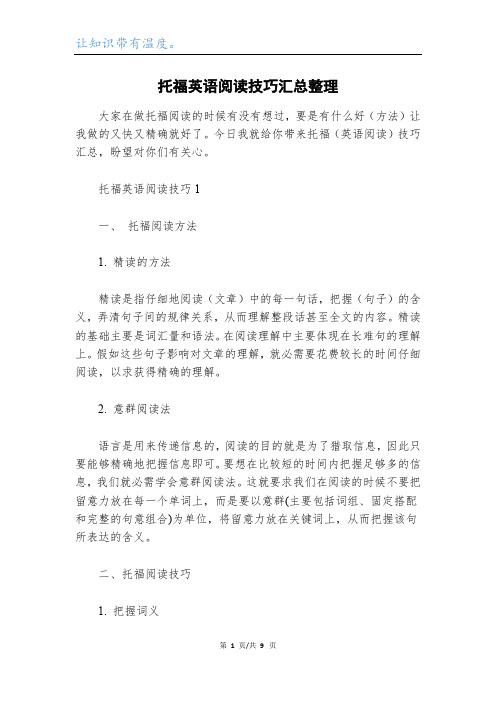
托福英语阅读技巧汇总整理大家在做托福阅读的时候有没有想过,要是有什么好(方法)让我做的又快又精确就好了。
今日我就给你带来托福(英语阅读)技巧汇总,盼望对你们有关心。
托福英语阅读技巧1一、托福阅读方法1. 精读的方法精读是指仔细地阅读(文章)中的每一句话,把握(句子)的含义,弄清句子间的规律关系,从而理解整段话甚至全文的内容。
精读的基础主要是词汇量和语法。
在阅读理解中主要体现在长难句的理解上。
假如这些句子影响对文章的理解,就必需要花费较长的时间仔细阅读,以求获得精确的理解。
2. 意群阅读法语言是用来传递信息的,阅读的目的就是为了猎取信息,因此只要能够精确地把握信息即可。
要想在比较短的时间内把握足够多的信息,我们就必需学会意群阅读法。
这就要求我们在阅读的时候不要把留意力放在每一个单词上,而是要以意群(主要包括词组、固定搭配和完整的句意组合)为单位,将留意力放在关键词上,从而把握该句所表达的含义。
二、托福阅读技巧1. 把握词义阅读过程中我们不免会遇到生词,有些考生在阅读中一遇到生词就停下来查字典,这种方法是不正确的。
有些词的确会影响到理解,查字典当然是一种方法,但是频繁地查字典不仅会影响阅读速度,还会影响对文章整体内容的理解。
所以,考生在平常要学会处理阅读中的生词,把握猜想生词的方法。
2. 理清结构阅读时,要先辨别清晰文章的体裁,理清文章的结构,把握主旨大意,找出文章的主题句。
理清文章结构有助于考生从整篇文章考虑,选出正确答案,避开因考虑不周或考虑片面而造成理解上的偏差。
阅读文章后的问题一般也是根据文章结构挨次提出的,所以理清文章结构还有助于考生在尽量短的时间内找到问题的答案。
3. 分析选项学会分析选项对于提高阅读分数有着重要的意义。
阅读选项的干扰项可能是下面几种状况:1)与文章细节部分相同、部分相悖;2)选项本身是正确的,但不是问题的答案,不符合题干的要求;3)与常识相符合,但在文章中没有提及;4)明显与文章信息不符等等。
托福阅读技巧与实战练习
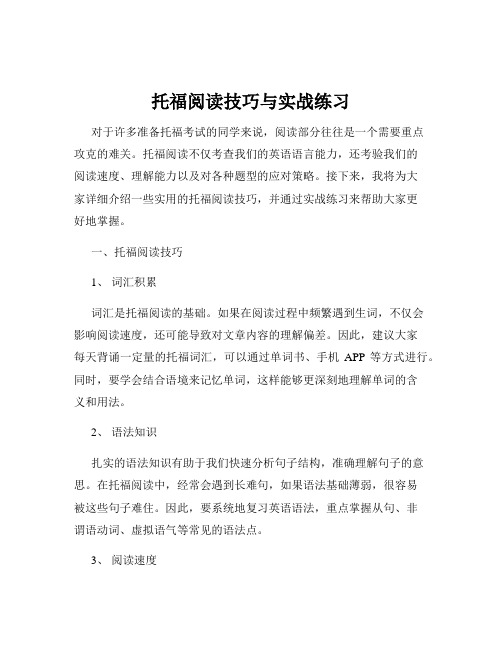
托福阅读技巧与实战练习对于许多准备托福考试的同学来说,阅读部分往往是一个需要重点攻克的难关。
托福阅读不仅考查我们的英语语言能力,还考验我们的阅读速度、理解能力以及对各种题型的应对策略。
接下来,我将为大家详细介绍一些实用的托福阅读技巧,并通过实战练习来帮助大家更好地掌握。
一、托福阅读技巧1、词汇积累词汇是托福阅读的基础。
如果在阅读过程中频繁遇到生词,不仅会影响阅读速度,还可能导致对文章内容的理解偏差。
因此,建议大家每天背诵一定量的托福词汇,可以通过单词书、手机APP 等方式进行。
同时,要学会结合语境来记忆单词,这样能够更深刻地理解单词的含义和用法。
2、语法知识扎实的语法知识有助于我们快速分析句子结构,准确理解句子的意思。
在托福阅读中,经常会遇到长难句,如果语法基础薄弱,很容易被这些句子难住。
因此,要系统地复习英语语法,重点掌握从句、非谓语动词、虚拟语气等常见的语法点。
3、阅读速度托福阅读的时间比较紧张,因此提高阅读速度非常重要。
在平时的练习中,可以通过限时阅读来训练自己的阅读速度。
一开始可能会觉得难以适应,但坚持一段时间后,阅读速度会有明显的提高。
同时,要学会快速浏览文章的标题、段落首句和尾句,以及关键词,这样能够在短时间内把握文章的大致内容。
4、题型分析托福阅读的题型多样,包括细节题、主旨题、推断题、词汇题等。
了解每种题型的特点和解题方法是取得高分的关键。
例如,细节题通常可以通过定位原文中的关键词来找到答案;主旨题则需要综合文章的整体内容进行概括;推断题需要在理解原文的基础上进行合理的推理。
5、做笔记在阅读过程中,可以适当地做笔记,记录文章的主要观点、重要细节以及自己的思考和疑问。
这样不仅有助于加深对文章的理解,还方便在回答问题时快速回顾。
二、实战练习1、模拟考试环境在进行实战练习时,要尽量模拟托福考试的真实环境,包括时间限制、考试场地等。
这样可以让我们更好地适应考试的紧张氛围,提高应对考试的能力。
托福阅读如何考满分,教你如何应对考试

托福阅读如何考满分,教你如何应对考试在考试期间,我们的记忆比理解更重要,在解题时,必须完全忠于原文,避免未通过同意做出任何主观假设。
今天我主要给大家分享〔托福〕阅读如何考满分,希望对你们有帮助!一、单词题目平常,注意单词的积存,努力达到随时随地记忆单词的境界。
事实上,我们在记忆单词时也可以适当地使用一些策略,就是我们可以集中精力记忆动词和形容词。
托福阅读考试后,你就会发现这种策略会事半功倍。
此外,关于我们不熟悉的词,我们应该主动在原文中寻找同义词或找到相关提示信息。
二、找代词指代宾语的主语在托福阅读考试中,它们主要以两种形式出现。
(1)it、one、their、its、that类,这类题主要是考查我们对并列关系的掌握,这时,我们应该主动去看单词所在的整句话,从已知单词中找出处于相同位置的单词。
(2)考查that、which中涉及的定语从句类型,在面对这类题时,我们应该有意识地找到从句中谓语动词的发起者或接受者,因为只有这样我们才干向胜利迈出第一步。
三、考查文章内容的题目在历年的托福阅读考试中,也有两大主要题型,即文章细节考查题和文章结构考查题。
1、文章细节考查题为了解决文章细节考查题,我们一般可以回到原文中进行定位,找到相近或相似的内容,然后得到答案。
常见的定位有以下三种:(1)题目本身给出定位。
(2)先做出一个段落的定位。
(3)位置主要夹在前后位置之间。
2、文章结构考查题请务必注意:(1)不要依据你读到的信息做出推论。
(2)不要把整篇文章从头到尾当作一个整体,尽量把段落分开。
依据经验,在考试中,整篇文章的最后一句出很多问题,所以应该仔细阅读这个重要的句子。
在整个托福阅读考试中,我们还应该了解到:(1)在考试期间,我们的记忆比理解更重要,在解题时,必须完全忠于原文,避免未通过同意做出任何主观假设。
(2)在做题的过程中,我们可以先简单地阅读原文(主要是每段的第一句和第二句),然后阅读题目,最后观察选项做出推断。
托福阅读快速提分技巧

托福阅读快速提分技巧对于许多准备托福考试的同学来说,阅读部分往往是一个重点和难点。
想要在托福阅读中取得高分,不仅需要具备一定的英语语言基础,还需要掌握一些有效的解题技巧和策略。
接下来,我将为大家分享一些托福阅读快速提分的技巧,希望能对大家有所帮助。
一、词汇积累词汇是托福阅读的基础,没有足够的词汇量,理解文章内容就会变得困难重重。
因此,在备考过程中,一定要注重词汇的积累。
首先,可以通过背单词书来扩大词汇量。
选择一本适合自己的托福词汇书,比如《托福词汇红宝书》《托福核心词汇 21 天突破》等,每天制定一个合理的背诵计划,坚持不懈地进行背诵。
其次,在阅读文章的过程中积累生词。
遇到不认识的单词,不要急于查字典,可以根据上下文猜测词义。
读完文章后,再将这些生词整理出来,进行记忆。
此外,还可以利用一些手机 APP 来辅助背单词,如百词斩、墨墨背单词等,这些APP 通常具有趣味性和便捷性,可以提高背单词的效率。
二、语法知识掌握扎实的语法知识对于理解托福阅读文章至关重要。
托福阅读中经常会出现一些长难句,如果语法基础薄弱,就很难准确理解句子的含义。
建议大家系统地复习一下英语语法,重点掌握句子结构、时态、语态、虚拟语气等知识点。
可以通过阅读语法书籍、做语法练习题等方式来加强语法学习。
在阅读文章时,遇到长难句要进行分析,找出句子的主干和修饰成分,从而理解句子的意思。
平时也可以多做一些长难句的翻译练习,提高对句子结构的敏感度。
三、阅读技巧1、快速浏览文章在阅读文章之前,先快速浏览一下文章的标题、副标题、段落小标题、图表等,了解文章的大致内容和结构。
这样在阅读过程中能够更好地把握文章的主旨和重点。
2、抓住关键词和关键句阅读过程中,要注意抓住关键词和关键句。
关键词通常是与文章主题相关的名词、动词、形容词等;关键句则是能够概括段落主旨或对理解文章有重要作用的句子。
通过抓住关键词和关键句,可以快速把握文章的要点。
3、学会推理和预测根据文章的上下文和已知信息,进行推理和预测。
托福阅读备考训练技巧和做题策略汇总介绍

托福阅读备考训练技巧和做题策略汇总介绍托福阅读备考可以分为很多环节,其中考生在解题这个环节一般需要练习的都是答题技巧和应对不同题型的基本思路策略,今日我给大家带来托福阅读备考训练技巧和做题策略汇总介绍,盼望可以关心到大家,下面我就和大家共享,来观赏一下吧。
托福阅读备考训练技巧和做题策略汇总介绍托福阅读备考训练技巧分析1,粗看下文章的段数,对每段也许几道题有个预期。
(比如只有5段,那长段确定是3道题)粗看每段第一句话,对文章的整体意思心中有数。
2,每段段首变成中文理解,以快速的进入状态,并记忆主要意思。
(就算只有一道词汇题,这段的段首也要读)3,每读一段整理一次规律,A支持的观点是什么?A的观点的问题是什么?B的观点是什么?4,鉴于每段都会出细节题,假如有词汇题等先只看一句话,做完了要看到细节题问的什么再看文章,鉴于有四个选项,选一个对的或者不对的,看的时候自己要边看边总结,比如总结出三个步骤,解释了三个方面的问题,或者其他。
5,检查,每个不确定的题都做记录,假如专心理解全文,一般能省下时间检查。
托福阅读做题策略介绍词汇题、句子简化题:只读该句不读完整段;主旨题:看每段的主旨句即可;修辞目的题:推想举例意图,查看上下句;句子插入题:分析详细待插入的句子,代入验证即可;细节题,排解列举题:确定关键词,查看上下句;推断题:明确示意确并没有详细写出的意图,推想关键句;指代题:分析指代句的特征,主要依据就近原则查看上文。
托福阅读真题原题+题目Glaciers are large masses of ice on land that show evidence of past or present movement. They grow by the gradual transformation of snow into glacier ice.A fresh snowfall is a fluffy mass of loosely packed snowflakes, small delicate ice crystals grown in the atmosphere. As the snow ages on the ground for weeks or months, the crystals shrink and become more compact, and the whole mass becomes squeezed together into a more dense form, granular snow. As new snow falls and buries the older snow, the layers of granular snow further compact to form firm, a much denser kind of snow, usually a year or more old, which has little pore space. Further burial and slow cementation — a process by which crystals become bound together in a mosaic of intergrown ice crystals — finally produce solid glacial ice. In this process of recrystallization, the growth of new crystals at the expense of old ones, the percentage of air is reduced from about 90 percent for snowflakes to less than 20 percent for glacier ice. The whole process may take as little as a few years, but more likely ten or twenty years or longer. The snow is usually many meters deep by the time the lower layers are converted into ice.In cold glaciers those formed in the coldest regions of the Earth, the entire mass of ice is at temperatures below the melting point and no free water exists. In temperate glaciers, the ice is at the melting point at every pressure level within the glacier, and free water is present as small drops or as larger accumulations in tunnels within or beneath the ice.Formation of a glacier is complete when ice has accumulated to a thickness (and thus weight) sufficient to make it move slowly under pressure, in much the same way that solid rock deep within the Earth can change shape without breaking. Once that point is reached, the ice flows downhill, either as a tongue of ice filling a valley or as thick ice cap that flows out in directions from the highest central area where the most snow accumulates. The trip down leads to the eventual melting of ice.1. Which of the following does the passage mainly discuss?(A) The effect of glaciers on climate(B) Damage from glaciers(C) Glacier formation(D) The location of glaciers2. Which of the following will cause density within the glacier to increase?(A) Increased water and air content(B) Pressure from the weight of new snow(C) Long periods of darkness and temperature variations(D) Movement of the glacier3. The word bound in line 9 is closest in meaning to(A) covered(B) chosen(C) planned(D) held4. Which of the following will be lost is a glacier forms?(A) Air(B) Pressure(C) Weight(D) Rocks5. According to the passage , which of the following is the LEAST amount of time necessary forglacial ice to form?(A) several months(B) several years(C) at least fifty years(D) a century6. The word converted in line 15 is closest in meaning to(A) changed(B) delayed(C) promoted(D) dissolved7. What is the purpose of the material in paragraph three?(A) To define two types of glaciers(B) To contrast glacier ice with non-glacier ice(C) To present theories of glacier formation(D) To discuss the similarities between glacial types8. In temperate glaciers, where is water found?(A) Only near the surface(B) In pools of various depths(C) In a thin layer below the firm(D) In tunnels9. The word it in line 21 refers to(A) formation(B) ice(C) thickness(D) weight10. It can be inferred from the last paragraph that a glacier(A) can revert to a fluffy mass(B) maintains the same shape throughout the glacial process(C) is too cold to be thoroughly studied(D) can contribute water to lakes, rivers, or oceansPASSAGE 74 CBDAB AADBD托福阅读真题原题+题目In eighteenth-century colonial America, flowers and fruit were typically the province of the botanical artist interested in scientific illustration rather than being the subjects of fine art. Early in the nineteenth century, however, the Peale family of Philadelphia established the still life, a picture consisting mainly of inanimate objects, as a valuable part of the artists repertoire. The fruit paintings by James and Sarah Miriam Peale are simple arrangements of a few objects, handsomely colored, small in size, and representing little more than what they are. In contrast were the highly symbolic, complex compositions by Charles Bird King, with their biting satire and critical social commentary. Each of these strains comminuted into and well past mid-century.John F. Francis (1808-86) was a part of the Pennsylvania still-life tradition that arose, at least in part, from the work of the Peales. Most ofhis still lifes date from around 1850 to 1875. Luncheon Still Life looks like one of the Peales pieces on a larger scale, with greater complexity resulting from the number of objects. It is also indebted to the luncheon type of still life found in seventeenth-century Dutch painting. The opened bottles of wine and the glasses of wine partially consumed suggest a number of unseen guests. The appeal of the fruit and nuts to our sense of taste is heightened by the juicy orange, which has already been sliced. The arrangement is additive, that is, made up of many different parts, not always compositionally integrated, with all objects of essentially equal importance.About 1848, Severin Roesen came to the United States from Germany and settled in New York City, where he began to paint large, lush still lifes of flowers, fruit, or both, often measuring over four feet across. Still Life with fruit and champagne is typical in its brilliance of color, meticulous rendering of detail, compact composition, and unabashed abundance. Rich in symbolic overtones, the beautifully painted objects carry additional meanings — butterflies or fallen buds suggest the impermanence of life, a birds nest with eggs means fertility, and so on. Above all, Roesens art expresses the abundance that America symbolized to many of its citizens.1. What does the passage mainly discuss?(A) The artwork of James and Sarah Miriam Peale(B) How Philadelphia became a center for art in the nineteenth century(C) Nineteenth-century still-life paintings in the United States(D) How botanical art inspired the first still-life paintings2. Which of the following is mentioned as a characteristic of the stilllifes of James and SarahMiriam Peale?(A) simplicity(B) symbolism(C) smooth texture(D) social commentary3. The word biting in line 8 is closest in meaning to(A) simple(B) sorrowful(C) frequent(D) sharp4. The word It in line 13 refers to(A) Luncheon Still Life(B) one of the Peales pieces(C) a larger scale(D) the number of objects5. The word heightened in line 16 is closest in meaning to(A) complicated(B) directed(C) observed(D) increased6. The word meticulous in line 23 is closest in meaning to(A) careful(B) significant(C) appropriate(D) believable7. Which of the following terms is defined in the passage ?(A) repertoire (line 5)(B) satire (line 8)(C) additive (line 17)(D) rendering (line 23)8. All of the following are mentioned as characteristics of Roesens still lifes EXCEPT that they(A) are symbolic(B) use simplified representations of flowers and fruit(C) include brilliant colors(D) are large in size9. Which of the following is mentioned as the dominant theme in Roesens painting?(A) Fertility(B) Freedom(C) Impermanence(D) AbundancePASSAGE 89 CADAD ACBD托福阅读备考训练技巧和做题策略汇总介绍文章到此就结束了,欢迎大家下载使用并丰富,共享给更多有需要的人。
- 1、下载文档前请自行甄别文档内容的完整性,平台不提供额外的编辑、内容补充、找答案等附加服务。
- 2、"仅部分预览"的文档,不可在线预览部分如存在完整性等问题,可反馈申请退款(可完整预览的文档不适用该条件!)。
- 3、如文档侵犯您的权益,请联系客服反馈,我们会尽快为您处理(人工客服工作时间:9:00-18:30)。
托福阅读备考训练技巧和做题策略
汇总介绍
托福阅读备考可以分为许多环节,其中考生在解题这个环节一般需要练习的都是答题技巧和应对不同题型的基本思路策略,今天给大家带来托福阅读备考训练技巧和做题策略汇总介绍,希望可以帮助到大家,下面就和大家分享,来欣赏一下吧。
托福阅读备考训练技巧和做题策略汇总介绍
托福阅读备考训练技巧分析
1,粗看下*的段数,对每段大概几道题有个预期。
(比如只有5段,那长段肯定是3道题)粗看每段第一句话,对*的整体意思心中有数。
2,每段段首变成中文理解,以迅速的进入状态,并记忆主要意思。
(就算只有一道词汇题,这段的段首也要读)
3,每读一段整理一次逻辑,A支持的观点是什么?A的观点的问题是什么?B的观点是什么?
4,鉴于每段都会出细节题,如果有词汇题等先只看一句话,做完了要看到细节题问的什么再看*,鉴于有四个选项,选一个
对的或者不对的,看的时候自己要边看边总结,比如总结出三个步骤,解释了三个方面的问题,或者其他。
5,检查,每个不确定的题都做记录,如果用心理解全文,一般能省下时间检查。
托福阅读做题策略介绍
词汇题、句子简化题:只读该句不读完整段;
主旨题:看每段的主旨句即可;
修辞目的题:推测作者举例意图,查看上下句;
句子插入题:分析具体待插入的句子,代入验证即可;
细节题,排除列举题:确定关键词,查看上下句;
推断题:作者明确暗示确并没有具体写出的意图,推测关键句;
指代题:分析指代句的特征,主要根据就近原则查看上文。
托福阅读真题原题+题目
Glaciers are large masses of ice on land that show evidence of past or present movement. They grow by the gradual transformation of snow into glacier ice.
A fresh snowfall is a fluffy mass of loosely packed snowflakes, small delicate ice crystals grown in the atmosphere. As the snow ages on the ground for weeks or months, the crystals shrink and become more compact, and the whole mass becomes squeezed together into a more dense form, granular snow. As new snow falls and buries the older snow, the layers of granular snow further compact to form firm, a much denser kind of snow, usually a year or more old, which has little pore space. Further burial and slow cementation — a process by which crystals become bound together in a mosaic of intergrown ice crystals — finally produce solid glacial ice. In this process of recrystallization, the growth of new crystals at the expense of old ones, the percentage of air is reduced from about 90 percent for snowflakes to less than 20 percent for glacier ice. The whole process may take as little as a few years, but more likely ten or twenty years or longer. The snow is usually many meters deep by the time the lower layers are converted into ice.
In cold glaciers those formed in the coldest regions of the Earth, the entire mass of ice is at temperatures below the melting point and no free water exists. In temperate glaciers, the ice is at the melting point at every pressure level within the glacier, and free water is present as small drops or as larger accumulations in tunnels within or beneath the ice.
Formation of a glacier is complete when ice has accumulated to a thickness (and thus weight) sufficient to make it move slowly under pressure, in much the same way that solid rock deep within the Earth can change shape without breaking. Once that point is reached, the ice flows downhill, either as a tongue of ice filling a valley or as thick ice cap that flows out in directions from the highest central area where the most snow accumulates. The trip down leads to the eventual melting of ice.
1. Which of the following does the passage mainly discuss?
(A) The effect of glaciers on climate
(B) Damage from glaciers
(C) Glacier formation
(D) The location of glaciers
2. Which of the following will cause density within the glacier to increase?
(A) Increased water and air content
(B) Pressure from the weight of new snow
(C) Long periods of darkness and temperature variations
(D) Movement of the glacier
3. The word bound in line 9 is closest in meaning to
(A) covered
(B) chosen
(C) planned
(D) held
4. Which of the following will be lost is a glacier forms?
(A) Air
(B) Pressure
(C) Weight
(D) Rocks
5. According to the passage , which of the following is the LEAST amount of time necessary for
glacial ice to form?
(A) several months
(B) several years
(C) at least fifty years
(D) a century
6. The word converted in line 15 is closest in meaning to
(A) changed
(B) delayed
(C) promoted
(D) dissolved
7. What is the purpose of the material in paragraph three?
(A) To define two types of glaciers
(B) To contrast glacier ice with non-glacier ice
(C) To present theories of glacier formation
(D) To discuss the similarities between glacial types
8. In temperate glaciers, where is water found?
(A) Only near the surface
(B) In pools of various depths
(C) In a thin layer below the firm
(D) In tunnels。
